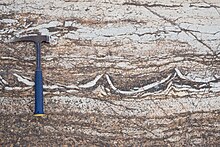Teepee structure

Teepee (also spelled tepee or tipi) structures are sedimentary structures interpreted to represent formation in peritidal environments. Teepees are largely the result of evaporation of water and subsequent precipitation of minerals within sediment, resulting in expansion and buckling to form a teepee-like shape. Their name originates from geologists working in the Guadalupe Mountains, who noted their appearance in cross-section resembles that of a Native American teepee.[1]
Teepee structures have been observed in rocks more than 2.7 billion years old,[2] and can be seen forming in modern environments on Earth, such as the Dead Sea.[3]
Formation
Several mechanisms are involved in the formation of teepee structures, with displacive forces resulting from mineral precipitation likely the most important.[4][5]
Displacive force from mineral precipitation
The precipitation of minerals (e.g., calcite, gypsum, halite) within sediments results in expansive forces. If supersaturated pore waters are maintained during mineral precipitation, the forces can be sufficient to deform sedimentary beds. This conditions would be particularly prevalent in areas with low rates of precipitation and high rates of evaporation, such as sabkhas.[4][5]
Hydration of salts
The hydration of some minerals is associated with a significant increase in volume. The hydration of anhydrite to form gypsum, for example, results in an increase of volume by 63%.[6] In arid environments where anhydrite is widespread, a storm or spring tide could case rapid hydration and swelling, resulting in increased stresses and buckling within the sediment to form teepees.[4][5]

Thermal expansion
Different rocks expanded by different amounts when heated. A 10 m wide sheet of limestone will become approximately 4 mm wider when heated by 50°C, whereas a rock with significant amounts of sulphate or chloride minerals may expanded by 12 - 24 mm in width. While this is likely insufficient for the generation of teepees by itself, it may work in conjunction with the other mechanisms.[4][5]
Earthquake
Some have suggested that teepee structures may be the result of seismic activity deforming sedimentary layers.[7]
References
- ^ Adams, John Emery; Frenzel, Hugh N. (1950-07-01). "Capitan Barrier Reef, Texas and New Mexico". The Journal of Geology. 58 (4): 289–312. Bibcode:1950JG.....58..289A. doi:10.1086/625749. ISSN 0022-1376. S2CID 140626916.
- ^ Flannery, D. T.; Walter, M. R. (February 2012). "Archean tufted microbial mats and the Great Oxidation Event: new insights into an ancient problem". Australian Journal of Earth Sciences. 59 (1): 1–11. Bibcode:2012AuJES..59....1F. doi:10.1080/08120099.2011.607849. ISSN 0812-0099. S2CID 53618061.
- ^ Talbot, C. J.; Stanley, W.; Soub, R.; Al-Sadoun, N. (1996). "Epitaxial salt reefs and mushrooms in the southern Dead Sea". Sedimentology. 43 (6): 1025–1047. Bibcode:1996Sedim..43.1025T. doi:10.1111/j.1365-3091.1996.tb01517.x. ISSN 1365-3091.
- ^ a b c d Assereto, Riccardo L. a. M.; Kendall, Christopher G. St C. (1977). "Nature, origin and classification of peritidal tepee structures and related breccias". Sedimentology. 24 (2): 153–210. Bibcode:1977Sedim..24..153A. doi:10.1111/j.1365-3091.1977.tb00254.x. ISSN 1365-3091.
- ^ a b c d Kendall, Christopher G. St C.; Warren, John (1987). "A review of the origin and setting of tepees and their associated fabrics" (PDF). Sedimentology. 34 (6): 1007–1027. Bibcode:1987Sedim..34.1007K. doi:10.1111/j.1365-3091.1987.tb00590.x. ISSN 1365-3091.
- ^ Zanbak, Caner; Arthur, Randolph C. (1986-11-01). "Geochemical and Engineering Aspects of Anhydrite/Gypsum Phase Transitions". Environmental and Engineering Geoscience. xxiii (4): 419–433. Bibcode:1986EEGeo..23..419Z. doi:10.2113/gseegeosci.xxiii.4.419. ISSN 1078-7275.
- ^ Pratt, Brian R (2002-11-01). "Tepees in peritidal carbonates: origin via earthquake-induced deformation, with example from the Middle Cambrian of western Canada". Sedimentary Geology. 153 (3): 57–64. Bibcode:2002SedG..153...57P. doi:10.1016/S0037-0738(02)00318-4. ISSN 0037-0738.
